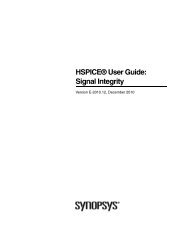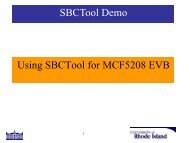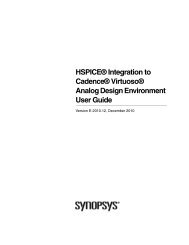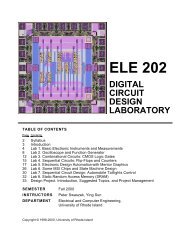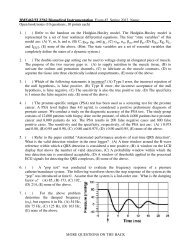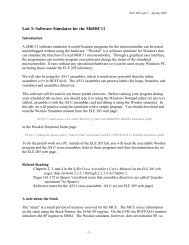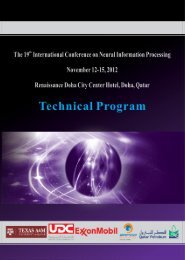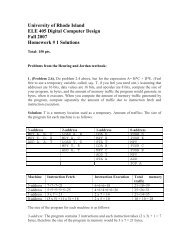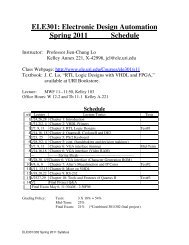Motorola Semiconductor Application Note MC68HC11 EEPROM ...
Motorola Semiconductor Application Note MC68HC11 EEPROM ...
Motorola Semiconductor Application Note MC68HC11 EEPROM ...
You also want an ePaper? Increase the reach of your titles
YUMPU automatically turns print PDFs into web optimized ePapers that Google loves.
Order this document<br />
by AN427/D<br />
<strong>Motorola</strong> <strong>Semiconductor</strong> <strong>Application</strong> <strong>Note</strong><br />
AN427<br />
<strong>MC68HC11</strong> <strong>EEPROM</strong> Error Correction Algorithms in C<br />
By Richard Soja<br />
<strong>Motorola</strong> Ltd.<br />
East Kilbride, Glasgow<br />
Introduction<br />
This application note describes a technique for correcting 1-bit errors<br />
and detecting 2-bit errors in a block of data ranging from 1 to 11 bits in<br />
length. The technique applied is a modified version of a Hamming code<br />
and has been implemented entirely in C. Additional functions have been<br />
provided to program and read the <strong>EEPROM</strong> (electrically erasable<br />
programmable read-only memory) on an M68HC11 microcontroller unit<br />
using the error encoding and decoding algorithms.<br />
Encoding and Decoding Algorithms<br />
Some texts (see References [1] and [2]) describe the use of<br />
simultaneous equations to calculate check bits in Hamming distance-3<br />
error correcting codes. These codes are so named because there are at<br />
least three bit differences between each valid code in the set of available<br />
codes. The codes are relatively easy to generate and can be used to<br />
correct 1-bit errors. However, their main drawback is that if 2-bit errors<br />
occur, then the correction will be made erroneously. This is because the<br />
condition of 2-bit errors corresponds exactly with a 1-bit error from<br />
another valid code.<br />
© <strong>Motorola</strong>, Inc., 1990, 2000 AN427
<strong>Application</strong> <strong>Note</strong><br />
The technique described here is based on an algorithmic strategy which<br />
produces Hamming distance-4 codes over the range of 1 to 11 data bits.<br />
This type of code is capable of correcting single-bit errors and detecting<br />
2-bit errors.<br />
Alternatively, if the errors are only to be detected, without correction,<br />
then up to three bit errors can be detected. The reason for this is that the<br />
condition of a 3 bit error in one code corresponds to a 1-bit error from an<br />
adjacent valid code. The implication of this is that if the algorithms are<br />
used to correct errors, then a 3-bit error will be corrected erroneously<br />
and flagged as a 1-bit error.<br />
The C program is divided into three modules, plus one header file. For<br />
example:<br />
1. EECOR1.C — This is the main program segment and serves only<br />
to illustrate the method of calling and checking the algorithms.<br />
2. HAMMING.C — This module contains the functions which encode<br />
and decode the data.<br />
3. EEPROG.C — This module contains the <strong>EEPROM</strong> programming<br />
functions tailored for an M68HC11 MCU.<br />
4. HC11REG.H — This is the header file which contains the<br />
M68HC11 input/output (I/O) register names defined as a C<br />
structure.<br />
Implementation of Error Correction Strategy<br />
The basic principle of decoding the error correcting codes is to use a<br />
parity check matrix, H, to generate a syndrome word which identifies the<br />
error. The H matrix can be generated as follows:<br />
1. Identify how many data bits are needed. For example: 8 data bits<br />
2. Use the standard equation to derive the number of check bits<br />
required: If k is the number of check bits and m the number of data<br />
bits, then for the Hamming bound to be satisfied:<br />
2 k ≥ m + k + 1<br />
AN427<br />
2 MOTOROLA
<strong>Application</strong> <strong>Note</strong><br />
Implementation of Error Correction Strategy<br />
A simple way to understand why this equation holds true is as<br />
follows: If one can generate a check code which is able to identify<br />
where a single error occurs in a bit stream, then the check code<br />
must have at least the same number of unique combinations as<br />
there are bits in the bit stream, plus one extra combination to<br />
indicate that no error has occurred. For example, if the total<br />
number of data plus check bits were seven, then the check code<br />
must consist of three bits to cover the range one to seven plus one<br />
extra (0) to indicate no error at all.<br />
In this example, if m = 8, then by rearranging the earlier equation:<br />
2 k – k – 1 ≥ 8<br />
One way to solve for k is to just select values of k starting at, say,<br />
1 and evaluating until the bound is reached. This method is<br />
implemented by algorithm in function InitEncode() in Module<br />
HAMMING.C.<br />
For m = 8, the solution is k = 4. <strong>Note</strong> that this value exceeds the<br />
Hamming bound, which means that additional data bits can be<br />
added to the bit stream, thus increasing the efficiency of the code.<br />
In fact, the maximum number of data bits is 11 in this case.<br />
3. A parity matrix, H, is created from a "horizontally oriented" binary<br />
table. The number of columns (b1 to b12) in the matrix correspond<br />
to the total number of data and check bits and the number of rows<br />
(r1 to r4) to the number of check bits.<br />
i.e. b1 b2 b3 b4 b5 b6 b7 b8 b9 b10 b11 b12<br />
r1 1 0 1 0 1 0 1 0 1 0 1 0<br />
r2 0 1 1 0 0 1 1 0 0 1 1 0<br />
r3 0 0 0 1 1 1 1 0 0 0 0 1<br />
r4 0 0 0 0 0 0 0 1 1 1 1 1<br />
Because the H matrix in this form is simply a truncated 4-bit binary<br />
table, it can easily be generated by algorithm.<br />
AN427<br />
MOTOROLA 3
<strong>Application</strong> <strong>Note</strong><br />
4. The position of all the check bits (C1 to C4) within the encoded<br />
word is the position of the single 1s in the columns of H. The<br />
remaining bits correspond to the data bits (D1 to D8).<br />
i.e. C1 C2 D1 C3 D2 D3 D4 C4 D5 D6 D7 D8<br />
1 0 1 0 1 0 1 0 1 0 1 0<br />
0 1 1 0 0 1 1 0 0 1 1 0<br />
0 0 0 1 1 1 1 0 0 0 0 1<br />
0 0 0 0 0 0 0 1 1 1 1 1<br />
5. Each check bit is generated by taking each row of H in turn and<br />
modulo-2 adding all bits with a 1 in them e<br />
xcept the check bit positions.<br />
i.e. C1 = D1+D2+D4+D5+D7<br />
C2 = D1+D3+D4+D6+D7<br />
C3 = D2+D3+D4+D8<br />
C4 = D5+D6+D7+D8<br />
6. The syndrome, s, is the binary weighted value of all check bits.<br />
i.e. s = 1*C1+2*C2+4*C3+8*C4<br />
The error position (i.e. column) is determined by the value of the<br />
syndrome word, provided it is not zero. A zero syndrome means<br />
no error has occurred. <strong>Note</strong> that this error correction technique<br />
can correct errors in either data or check bits, which is not<br />
necessarily the case with certain other error correction strategies.<br />
The advantage of this method, where the check bits are<br />
interspersed in a binary manner throughout the code word, is that<br />
the error position can be calculated by algorithm.<br />
An important point to note is that the parity check matrix described<br />
earlier generates Hamming distance-3 codes, which means that<br />
two errors will cause erroneous correction. This can be fixed by<br />
adding an extra parity check bit, C5, which is the modulo-2<br />
addition of all data and check bits together.<br />
i.e. C5 = C1+C2+D1+C3+D2+D3+D4+C4+D5+D6+D7+D8<br />
The code word then becomes:<br />
C1 C2 D1 C3 D2 D3 D4 C4 D5 D6 D7 D8 C5<br />
AN427<br />
4 MOTOROLA
<strong>Application</strong> <strong>Note</strong><br />
Efficiency<br />
To determine if an uncorrectable error has occurred (i.e. two<br />
errors) in the received word, the extra parity bit is tested. If the<br />
syndrome is non-zero and the parity bit is wrong, then a<br />
correctable error has occurred. If the syndrome is non-zero and<br />
the parity bit is correct, then an uncorrectable error has occurred.<br />
Efficiency<br />
The following table lists the relative efficiencies of this algorithm, against<br />
data size.<br />
Data Bits Encoded Bits Efficiency %<br />
1 4 25<br />
2<br />
6<br />
33<br />
3 7 43<br />
4 8 50<br />
5 10 50<br />
6 11 55<br />
7 12 58<br />
8 13 62<br />
9 14 64<br />
10 15 67<br />
11 16 69<br />
The implementation of these techniques are given in Module<br />
HAMMING.C.<br />
In order to maintain orthogonality in the <strong>EEPROM</strong> algorithms, the<br />
encoded data used by the functions in Module EEPROG.C are forced<br />
to either 1-byte or 2-byte (word) sizes. This also eliminates the<br />
complexities of packing and unpacking data in partially filled bytes.<br />
AN427<br />
MOTOROLA 5
<strong>Application</strong> <strong>Note</strong><br />
Conclusions<br />
In this application note, the encoding algorithm’s generator matrix is the<br />
same as the parity check matrix.<br />
The C functions and in Module HAMMING.C return a<br />
status value — 0, 1, or 2 — which indicates whether the data has no<br />
errors, one corrected error, or two erroneously corrected errors. This<br />
means that if the status value is 0 or 1, then the data can be assumed<br />
good. If the status value is 2, then the data will be bad.<br />
Alternatively, the functions can be used for error detection only, without<br />
correction. In this case, a status value of 1 corresponds to either 1- or<br />
3-bit errors, while a status value of 2 indicates that 2-bit errors have<br />
occurred.<br />
By using the C functions listed in this application note, the encoded data<br />
size can easily be changed dynamically. To do this, the function<br />
must be called with the required new data size. The global<br />
variables used by all the encoding, decoding, and <strong>EEPROM</strong><br />
programming and reading functions are automatically updated. This<br />
allows the encoding and error correction process to be virtually<br />
transparent to the user. In addition, the functions and will<br />
automatically increment the address pointer by the correct encoded data<br />
size set up by . This simplifies the structure of loops to<br />
program and read back data. Example code is provided in Module<br />
EECOR1.C.<br />
The encoding and decoding algorithms listed here may be applied to<br />
other forms of data, such as that used in serial communications or for<br />
parallel data transfers.<br />
By incorporating the error correction or detection-only schemes<br />
described in this application note, the integrity of data storage and<br />
transfer can be greatly improved. The impact on <strong>EEPROM</strong> usage is to<br />
increase its effective reliability and extend its useful life beyond the<br />
manufacturer’s guaranteed specifications.<br />
AN427<br />
6 MOTOROLA
<strong>Application</strong> <strong>Note</strong><br />
References<br />
References<br />
[1] Carlson, Communication Systems, Chapter 9, McGraw-Hill.<br />
[2] Harman, Principles of the Statistical Theory of Communication,<br />
Chapter 5, McGraw-Hill.<br />
Module EECOR1.C<br />
Tests <strong>EEPROM</strong> error detection using a modified hamming encoding scheme.<br />
typedef unsigned char byte;<br />
typedef unsigned int word;<br />
/* Global variables used by main () */<br />
byte *ee_addr,*start_addr,*end_addr,i,Error;<br />
word data:<br />
/******************************************************************************************************/<br />
/*External global variables */<br />
extern byte CodeSize; /* = number of bits in encoded data */<br />
/* External Functions */<br />
extern byte read(word *data,byte **addr); /* Function returns error status */<br />
extern byte write(word data,byte **addr); /* "<br />
/* Table of Status returned by read and write functions<br />
Returned Status Condition<br />
0 No errors detected or corrected.<br />
1 One error detected and corrected.<br />
2 Two errors detected, but correction is erroneous.<br />
<strong>Note</strong>s:<br />
1/ When the returned value is 2, the function will returned a bad value in variable due to<br />
the inability to correctly correct two errors. also automatically increments the address pointer<br />
passed to it, to the next memory space. The incremented value takes into account the actual size of the<br />
encoded data. i.e. either 1 or 2 byte increment.<br />
2/ Function also performs a read to update and return an error status. This gives an immediate<br />
indication of whether the write was successful. also automatically increments the address<br />
pointer passed to it, to the next free memory space. The incremented value takes into account the actual<br />
size of the encoded data. i.e. either 1 or 2 byte increment.<br />
*/<br />
/******************************************************************************************************/<br />
int main ()<br />
{<br />
CodeSize=InitEncode(11); /* Get code size (less 1) needed */<br />
/* by 11 data bits */<br />
ee_addr=(byte *)0xb600; /* Initialise <strong>EEPROM</strong> start address */<br />
for(i=1;i
<strong>Application</strong> <strong>Note</strong><br />
Error=write(0x255,&ee_addr); /* Write 0x255 at next available address */<br />
CodeSize=InitEncode(4); /* Change number of data bits to 4 */<br />
start_addr=ee_addr; /* Save start address for this data */<br />
for(i=1;i
<strong>Application</strong> <strong>Note</strong><br />
Module HAMMING.C<br />
}<br />
{<br />
if (Code & 1) p=!p;<br />
Code>>=1;<br />
}<br />
return(p);<br />
word Power2(e)<br />
byte e;<br />
/*<br />
Returns 2^e<br />
*/<br />
{<br />
word P2;<br />
signed char i;<br />
P2=1;<br />
if ((signed char) (e)
<strong>Application</strong> <strong>Note</strong><br />
Check=0;<br />
CheckMask=1;<br />
CheckSize=CodeSize-DataSize;<br />
for (i=1;i
<strong>Application</strong> <strong>Note</strong><br />
Module EEPROG.C<br />
Check=(Code>>DataSize) & (Power2(CheckSize)-1; /* ignoring parity. */<br />
ErrorCheck=MakeCheck(Data);<br />
Syndrome=Check ^ ErrorCheck; /* Get bit position of error. */<br />
if (Syndrome>0) ErrFlag++; /* Increment flag if error exists */<br />
H=0;<br />
DataPos=0;<br />
CheckPos=DataSize;<br />
DataBit=TRUE;<br />
while ((H!+Syndrome) & (DataPos
<strong>Application</strong> <strong>Note</strong><br />
}<br />
regbase.TFLG1=0x80; /* clear any pending OC1 flag. */<br />
do;while ((regbase.TFLG1 & 0x80)==0); /* Wait for timeout flag. */<br />
void eeprog(val,byt,addr,count)<br />
byte val; /* val determines Erase or Write operation */<br />
byte byt; /* byt is byte to be programmed */<br />
byte *addr; /* addr is address of encoded byte in <strong>EEPROM</strong> */<br />
word count; /* count is number of E clock delays */<br />
{<br />
regbase.PPROG=val; /* Enable address/data latches */<br />
*addr=byt; /* Write value to required eeprom location */<br />
++regbase.PPROG; /* Enable voltage pump */<br />
if (count
<strong>Application</strong> <strong>Note</strong><br />
HC11REG.H<br />
HC11REG.H<br />
/* HC11 structure - I/O registers for <strong>MC68HC11</strong> */<br />
struct HC11IO {<br />
unsigned char PORTA; /* Port A - 3 input only, 5 output only */<br />
unsigned char Reserved;<br />
unsigned char PIOC; /* Parallel I/O control */<br />
unsigned char PORTC; /* Port C */<br />
unsigned char PORTB; /* Port B - Output only */<br />
unsigned char PORTCL; /* Alternate port C latch */<br />
unsigned char Reserved1;<br />
unsigned char DDRC; /* Data direction for port C */<br />
unsigned char PORTD; /* Port D */<br />
unsigned char DDRD; /* Data direction for port D */<br />
unsigned char PORTE; /* Port E */<br />
/* Timer Section */<br />
unsigned char CFORC; /* Compare force */<br />
unsigned char OC1M; /* Oc1 mask */<br />
unsigned char OC1D; /* Oc1 data */<br />
int TCNT; /* Timer counter */<br />
int TIC1; /* Input capture 1 */<br />
int TIC2; /* Input capture 2 */<br />
int TIC3; /* Input capture 3 */<br />
int TOC1; /* Output compare 1 */<br />
int TOC2; /* Output compare 2 */<br />
int TOC3; /* Output compare 3 */<br />
int TOC4; /* Output compare 4 */<br />
int TOC5; /* Output compare 5 */<br />
unsigned char TCTL1; /* Timer control register 1 */<br />
unsigned char TCTL2; /* Timer control register 2 */<br />
unsigned char TMSK1; /* Main timer interrupt mask 1 */<br />
unsigned char TFLG1; /* Main timer interrupt flag 1 */<br />
unsigned char TMSK2; /* Main timer interrupt mask 2 */<br />
unsigned char TFLG2; /* Main timer interrupt flag 2 */<br />
/* Pulse Accumulator Timer Control */<br />
unsigned char PACTL; /* Pulse Acc control */<br />
unsigned char PACNT /* Pulse Acc count */<br />
/* SPI registers */<br />
unsigned char SPCR; /* SPI control register */<br />
unsigned char SPSR; /* SPI status register */<br />
unsigned char SPDR; /* SPI data register */<br />
/* SCI registers */<br />
unsigned char BAUD; /* SCI baud rate control */<br />
unisgned char SCCR1; /* SCI control register 1 */<br />
unisgned char SCCR2; /* SCI control register 2 */<br />
unisgned char SCSR; /* SCI status register */<br />
unsigned char SCDR; /* SCI data register */<br />
/* A to D registers */<br />
unsigned char ADCTL; /* AD control register */<br />
unsigned char ADR[4]; /* Array of AD result registers */<br />
/* Define each result register */<br />
AN427<br />
MOTOROLA 13
<strong>Application</strong> <strong>Note</strong><br />
#define adr1 ADR[0]<br />
#define adr2 ADR[1]<br />
#define adr3 ADR[2]<br />
#define adr4 ADR[3]<br />
unsigned char Rsrv[4]; /* Reserved for A to D expansion<br />
/* System Configuration */<br />
unsigned char OPTION; /* System configuration options */<br />
unsigned char COPRST; /* Arm/Reset COP timer circuitry */<br />
unsigned char PPROG; /* <strong>EEPROM</strong> programming control reg */<br />
unsigned char HPRIO; /* Highest priority i-bit int & misc */<br />
unsigned char INIT; /* RAM - I/O mapping register */<br />
unsigned char TEST1; /* Factory TEST control register */<br />
unsigned char CONFIG; /* <strong>EEPROM</strong> cell - COP,ROM,& <strong>EEPROM</strong> en */<br />
};<br />
/* End of structure HC11 */<br />
AN427<br />
14 MOTOROLA
<strong>Application</strong> <strong>Note</strong><br />
HC11REG.H<br />
AN427<br />
MOTOROLA 15
<strong>Application</strong> <strong>Note</strong><br />
N O N - D I S C L O S U R E A G R E E M E N T R E Q U I R E D<br />
<strong>Motorola</strong> reserves the right to make changes without further notice to any products herein. <strong>Motorola</strong> makes no warranty, representation or guarantee regarding the suitability of its<br />
products for any particular purpose, nor does <strong>Motorola</strong> assume any liability arising out of the application or use of any product or circuit, and specifically disclaims any and all liability,<br />
including without limitation consequential or incidental damages. "Typical" parameters which may be provided in <strong>Motorola</strong> data sheets and/or specifications can and do vary in different<br />
applications and actual performance may vary over time. All operating parameters, including "Typicals" must be validated for each customer application by customer's technical experts.<br />
<strong>Motorola</strong> does not convey any license under its patent rights nor the rights of others. <strong>Motorola</strong> products are not designed, intended, or authorized for use as components in systems<br />
intended for surgical implant into the body, or other applications intended to support or sustain life, or for any other application in which the failure of the <strong>Motorola</strong> product could create a<br />
situation where personal injury or death may occur. Should Buyer purchase or use <strong>Motorola</strong> products for any such unintended or unauthorized application, Buyer shall indemnify and hold<br />
<strong>Motorola</strong> and its officers, employees, subsidiaries, affiliates, and distributors harmless against all claims, costs, damages, and expenses, and reasonable attorney fees arising out of,<br />
directly or indirectly, any claim of personal injury or death associated with such unintended or unauthorized use, even if such claim alleges that <strong>Motorola</strong> was negligent regarding the<br />
design or manufacture of the part. <strong>Motorola</strong> and are registered trademarks of <strong>Motorola</strong>, Inc. <strong>Motorola</strong>, Inc. is an Equal Opportunity/Affirmative Action Employer.<br />
How to reach us:<br />
USA/EUROPE/Locations Not Listed: <strong>Motorola</strong> Literature Distribution, P.O. Box 5405, Denver, Colorado 80217, 1-303-675-2140<br />
or 1-800-441-2447. Customer Focus Center, 1-800-521-6274<br />
JAPAN: <strong>Motorola</strong> Japan Ltd.; SPS, Technical Information Center, 3-20-1, Minami-Azabu, Minato-ku, Tokyo, 106-8573 Japan.<br />
81-3-3440-8573<br />
ASIA/PACIFIC: <strong>Motorola</strong> <strong>Semiconductor</strong>s H.K. Ltd.; Silicon Harbour Centre, 2 Dai King Street, Tai Po Industrial Estate,<br />
Tai Po, N.T., Hong Kong. 852-26668334<br />
Mfax, <strong>Motorola</strong> Fax Back System: RMFAX0@email.sps.mot.com; http://sps.motorola.com/mfax/;<br />
TOUCHTONE, 1-602-244-6609; US and Canada ONLY, 1-800-774-1848<br />
HOME PAGE: http://motorola.com/sps/<br />
Mfax is a trademark of <strong>Motorola</strong>, Inc.<br />
© <strong>Motorola</strong>, Inc., 2000<br />
AN427/D


